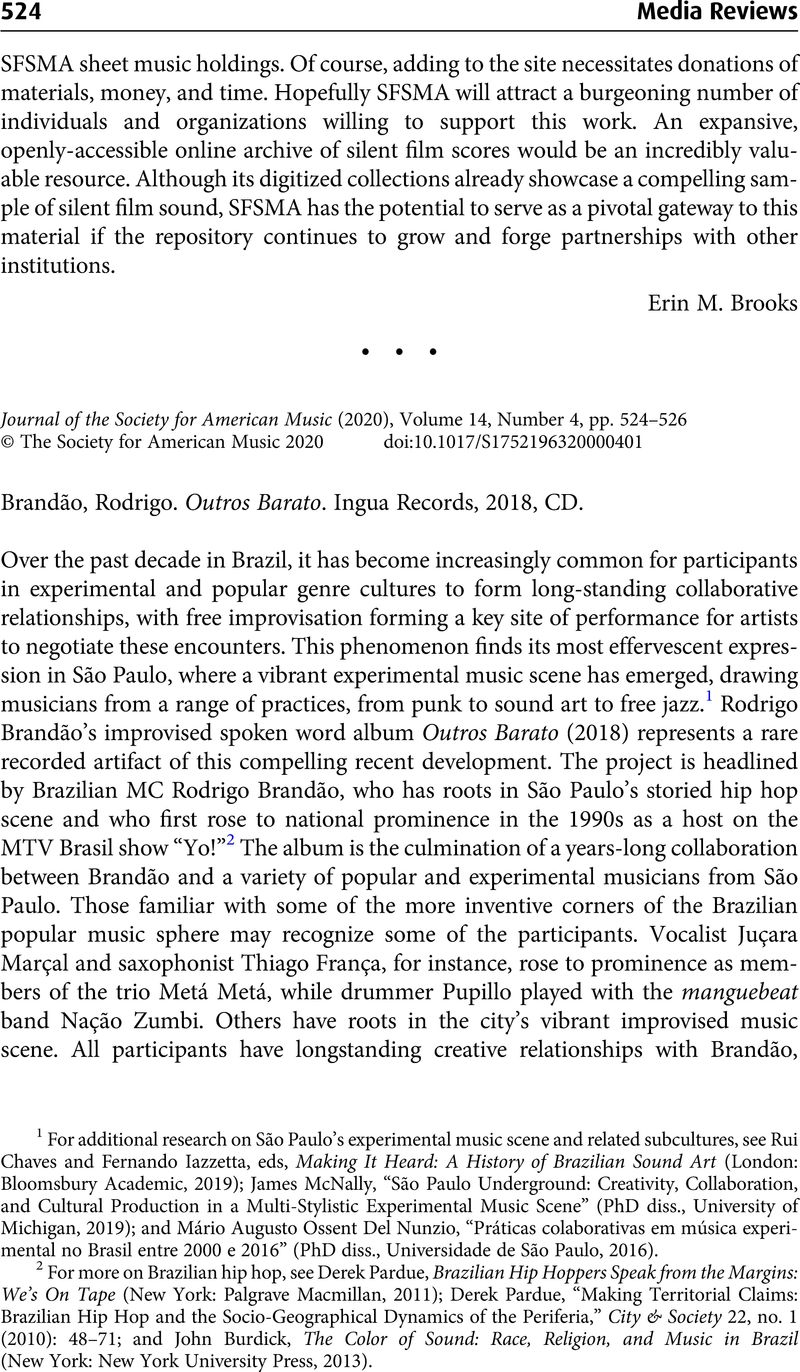No CrossRef data available.
Published online by Cambridge University Press: 19 November 2020

1 For additional research on São Paulo's experimental music scene and related subcultures, see Chaves, Rui and Iazzetta, Fernando, eds, Making It Heard: A History of Brazilian Sound Art (London: Bloomsbury Academic, 2019)Google Scholar; James McNally, “São Paulo Underground: Creativity, Collaboration, and Cultural Production in a Multi-Stylistic Experimental Music Scene” (PhD diss., University of Michigan, 2019); and Mário Augusto Ossent Del Nunzio, “Práticas colaborativas em música experimental no Brasil entre 2000 e 2016” (PhD diss., Universidade de São Paulo, 2016).
2 For more on Brazilian hip hop, see Pardue, Derek, Brazilian Hip Hoppers Speak from the Margins: We's On Tape (New York: Palgrave Macmillan, 2011)Google Scholar; Pardue, Derek, “Making Territorial Claims: Brazilian Hip Hop and the Socio-Geographical Dynamics of the Periferia,” City & Society 22, no. 1 (2010): 48–71CrossRefGoogle Scholar; and Burdick, John, The Color of Sound: Race, Religion, and Music in Brazil (New York: New York University Press, 2013)CrossRefGoogle Scholar.
3 Readers interested in learning more about Brazil's tradition of popular song (canção popular) can consult Tatit, Luiz, “Analysing Popular Songs,” in Popular Music Studies, trans. Leu, Lorraine, ed. Hesmondhalgh, David and Negus, Keith (London: Arnold, 2002), 33–50Google Scholar; Tatit, Luiz, O cancionista: composição de canções no Brasil (São Paulo: Edusp, 1996)Google Scholar; Tatit, Luiz, O século da canção (Cotia, SP: Ateliê, 2004)Google Scholar; Wisnik, José Miguel, “O minuto e o milênio ou Por favor, professor, uma década de cada vez,” in Anos 70: 1—Música Popular, ed. Autran, Margarida, Bahiana, Ana Maria, and Wisnik, José Miguel (Rio de Janeiro: Europa, 1980), 7–24Google Scholar; and Nestrovski, Arthur, Outras notas musicais: da idade media à música popular brasileira (São Paulo, PubliFolha, 2009)Google Scholar. Those interested in improvised musics in Brazil can examine sources such as Neto, Luiz Costa-Lima, “The Musical Universe of Hermeto Pascoal,” Popular Music and Society 34, no. 2 (2011): 133–61CrossRefGoogle Scholar; and Costa, Rogério Luiz Moraes, Música errante: o jogo da improvisação livre (São Paulo: Buscapé, 2016)Google Scholar.
4 The Brazilian popular music sphere has periodically featured collaborations between popular musicians and poets. Perhaps the most iconic of these was poet Waly Salomão's work with popular musicians such as Maria Bethânia and Gal Costa. See Dunn, Christopher, “Waly Salomão: Polyphonic Poet,” Review: Literature and Arts of the Americas 39, no. 2 (2006): 249–55Google Scholar.
5 For more on the use of Yoruba-derived terminology in Candomblé, see Capone, Stefania, Searching for Africa in Brazil: Power and Tradition in Candomblé (Durham, NC: Duke University Press, 2010)Google Scholar.